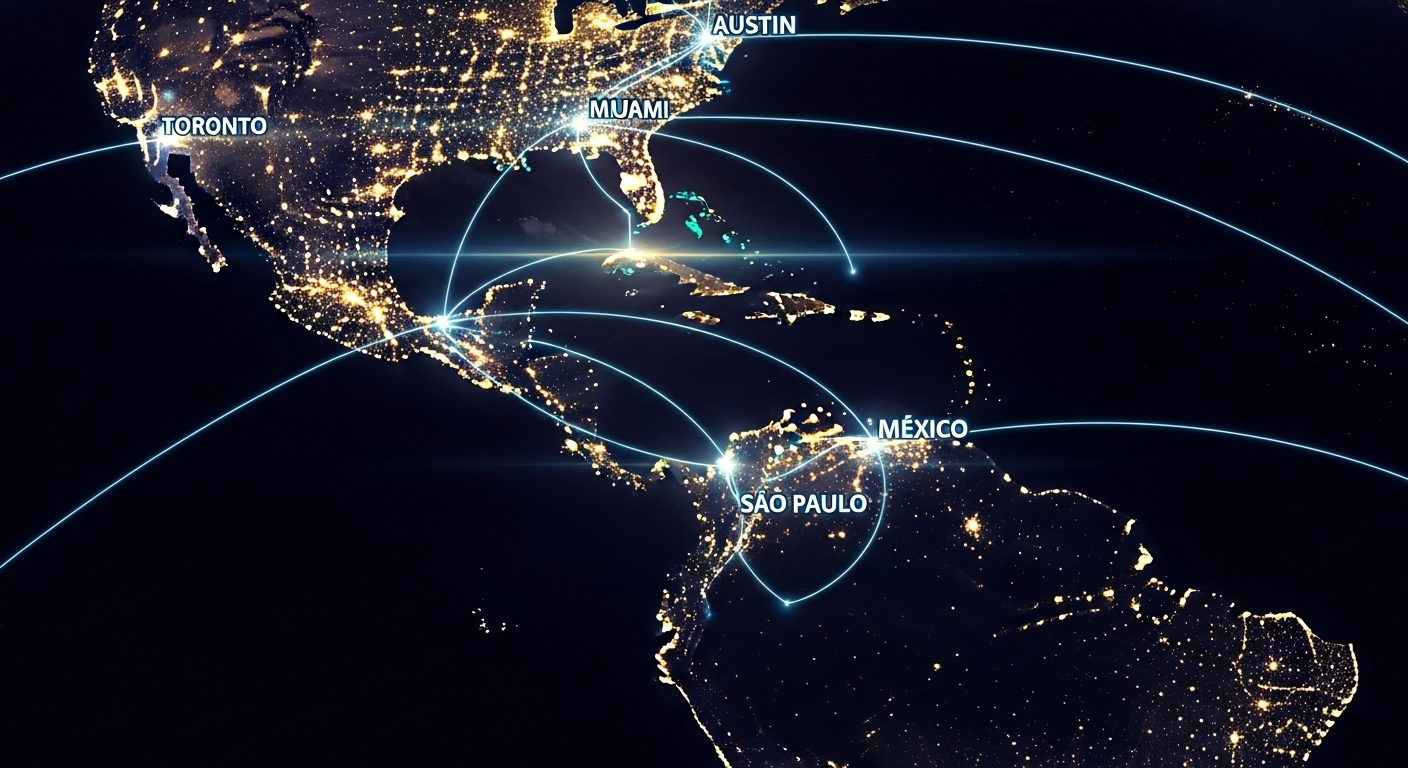The long-reigning narrative of a single, monolithic tech Mecca is officially obsolete. For decades, Silicon Valley was the undisputed center of the universe for founders, talent, and capital. But a profound shift, accelerated by the global move to remote work and a reassessment of economic priorities, has fractured that monolith. In its place, a new geography of innovation has emerged: a dynamic, interconnected network of specialized tech hubs spanning two continents. We call this the ‘Innovation Archipelago’—a chain of vibrant tech ‘islands’ from Canada to Chile, each with its own unique ecosystem, talent pool, and industry focus. This new map requires a new playbook. For founders and investors, success no longer hinges on planting a flag in Northern California, but on understanding how to navigate this decentralized network. This guide provides the compass to chart a course through the Americas’ most promising tech scenes, revealing where capital is flowing, where talent is migrating, and where the next wave of disruptive innovation is being born.
The Great Decentralization: Moving Beyond the Bay Area
The exodus from the San Francisco Bay Area wasn’t a sudden event but the culmination of years of mounting pressures. The exorbitant cost of living, fierce competition for talent, and market saturation created an environment where growth became increasingly challenging and expensive. When the pandemic normalized remote work, it effectively broke the geographic tether that bound tech companies to a single location. This ‘Great Decentralization’ was fueled by a simple calculation: businesses realized they could access top-tier talent without the Bay Area’s price tag, and employees discovered they could maintain high-impact careers while enjoying a better quality of life elsewhere. Data from think tanks and moving companies consistently shows a net migration of tech workers away from coastal California towards states like Texas, Florida, and Colorado. This isn’t just about cost savings; it’s a strategic diversification. Companies are building distributed teams to tap into a wider range of skills, perspectives, and market insights. This seismic shift has cleared the way for dozens of challenger cities to rise, not as replacements for Silicon Valley, but as vital, specialized nodes in a larger, more resilient network. The result is a more democratic and distributed innovation landscape where groundbreaking ideas can flourish far from the traditional epicenters of power.
Northern Beacons: Canada’s Ascendancy in AI and Deep Tech
While U.S. cities often dominate the tech hub conversation, Canada has quietly built a formidable presence, particularly in future-focused sectors like artificial intelligence and deep tech. The Toronto-Waterloo corridor stands as a global powerhouse for AI research and commercialization, anchored by world-class institutions like the University of Toronto and the Vector Institute. This ecosystem has nurtured foundational AI talent and spun out a remarkable number of startups that are now leaders in machine learning and neural networks. Government support through programs like the Pan-Canadian Artificial Intelligence Strategy has been instrumental, creating a fertile ground for both research and investment. On the west coast, Vancouver has carved out a distinct identity in SaaS, digital media, and gaming, benefiting from its proximity to Seattle and a steady influx of international talent. What makes Canada’s tech scene particularly compelling is its strategic approach to immigration. Policies like the Global Skills Strategy are designed to attract highly skilled tech workers from around the world, creating a diverse and dynamic talent pool that U.S. companies often struggle to replicate. For founders in AI, cleantech, or quantum computing, Canada’s northern beacons offer not just a market, but a deep, supportive ecosystem built for the long term.
The U.S. Challenger Islands: Sun Belt and Heartland Momentum
Within the United States, the most visible shift has been the meteoric rise of cities across the Sun Belt and, increasingly, the Heartland. Austin, Texas, once a quirky music town, has transformed into a major hub for hardware, enterprise software, and a slew of major tech company HQs and second offices. Its business-friendly climate and vibrant culture created a magnetic pull for talent and capital fleeing the coasts. Similarly, Miami has exploded onto the scene, branding itself as the capital of capital, particularly for FinTech, crypto, and Web3 innovation. The city’s leaders have aggressively courted investors and founders, creating a high-energy environment that has attracted significant venture funding. But the story extends beyond these headline-grabbers. Cities like Denver, Salt Lake City, and Nashville are developing their own specialized tech ecosystems, often centered around HealthTech, Cloud Computing, and logistics. Even the Midwest is experiencing a renaissance, with Chicago leveraging its deep corporate roots to foster a thriving B2B tech scene, and Columbus, Ohio, emerging as a surprisingly robust hub for insurtech and retail innovation. These ‘challenger islands’ offer a compelling value proposition: lower operational costs, access to untapped talent from regional universities, and a high quality of life that is increasingly important in the war for talent.
The LatAm Awakening: Rise of the ‘Silicon Tropics’
Perhaps the most transformative development in the Americas’ tech landscape is the explosive growth of Latin America. For years, the region was overlooked, but a confluence of factors—a massive, young, and digitally-native population, increasing mobile penetration, and a surge in venture capital—has ignited a tech renaissance. São Paulo, Brazil, has emerged as the undisputed FinTech capital of the hemisphere, producing unicorns like Nubank that are fundamentally reshaping financial services for millions. The city’s sheer scale and deep pool of talent make it a critical hub for any company looking to tap into the continent’s largest economy. Mexico City, with its strategic position as a bridge between North and South America, boasts a diverse and rapidly growing startup scene spanning e-commerce, logistics, and SaaS. Meanwhile, Bogotá, Colombia, has become a dark horse, with strong government support and a burgeoning community of entrepreneurs earning it the nickname ‘the Athens of South America.’ The opportunity in LatAm is staggering; a market of over 650 million people is rapidly coming online, creating greenfield opportunities to solve fundamental problems in banking, healthcare, education, and logistics with technology. International investors have taken note, with VC funding in the region reaching record highs, signaling that the ‘Silicon Tropics’ are no longer an emerging market but a core component of the global tech ecosystem.
Navigating by Sector: Finding Your Niche in the Archipelago
The defining characteristic of the Innovation Archipelago is specialization. Unlike the old model where one hub tried to be everything to everyone, the new landscape is a network of centers of excellence. For founders, this means strategic location choices are more critical than ever. The key is to align your company’s sector with a hub’s specific strengths in talent, research, and industry infrastructure. If you are building a FinTech or Web3 company, the capital and regulatory enthusiasm in Miami and the market scale of São Paulo make them prime destinations. For ventures rooted in artificial intelligence or quantum computing, the deep research ecosystem of the Toronto-Waterloo corridor is unparalleled. HealthTech startups will find a dense network of hospitals, research institutions, and specialized VCs in cities like Boston and Nashville. A B2B SaaS company might thrive in the corporate-rich environments of Chicago or Atlanta. Vancouver remains a global leader for gaming and visual effects, while Austin’s deep roots in semiconductor manufacturing make it a natural fit for hardware innovation. Navigating the archipelago successfully requires moving beyond a simple cost-of-living analysis and instead mapping your industry’s specific needs to the unique DNA of each tech island, ensuring you are positioned not just to survive, but to thrive within a supportive and synergistic ecosystem.
The Connective Tissue: Capital, Talent, and Digital Infrastructure
These tech hubs are not isolated islands; they are interconnected by powerful currents of capital, talent, and data. This ‘connective tissue’ is what transforms a collection of cities into a cohesive, hemispheric network. Venture capital is the primary current, with funds from established centers like Silicon Valley and New York now flowing freely to startups in Miami, Mexico City, and Bogotá. This cross-pollination of capital brings not just money, but also mentorship, expertise, and access to global markets. The second current is talent, which is now more mobile than ever thanks to remote and hybrid work models. A developer in Medellín can work seamlessly for a company headquartered in Toronto, and a marketing team in Austin can collaborate with a product team in São Paulo. This fluid movement of human capital allows companies to assemble ‘dream teams’ based on skill, not zip code. Finally, the entire archipelago is undergirded by robust digital infrastructure. The proliferation of high-speed internet, cloud computing platforms, and collaborative software tools has erased distances, making it possible to run a globally integrated operation from anywhere. Understanding these flows is crucial. Success in this new era is not about being on the biggest island, but about knowing how to leverage the currents that connect the entire archipelago, drawing resources and talent from across the network to build a truly resilient and globally competitive business.
Conclusion: Charting the Course in a Polycentric World
The tectonic plates of the tech world have shifted, replacing a single, dominant continent with a vast and varied archipelago of innovation. This new, decentralized map of the Americas represents a more resilient, diverse, and ultimately more dynamic future. For founders, the pressure to be in one specific location has been replaced by the strategic opportunity to choose a home base that aligns with their industry, culture, and growth objectives. For investors, the landscape has broadened, revealing compelling opportunities far beyond the traditional hunting grounds. The rise of hubs in Canada, the U.S. heartland, and across Latin America signifies a maturation of the global tech economy. This polycentric world demands a new mindset. It requires leaders to think not in terms of a single headquarters, but of a distributed network; not of a local talent pool, but of a global one. The journey through the Innovation Archipelago is ongoing, with new islands emerging and old ones evolving. The founders who succeed will be the best navigators—those who understand the unique strengths of each hub and master the currents of capital, talent, and data that connect them all. The future of technology in the Americas is not being built in one place; it’s being woven from the threads of this vibrant, cross-continental network.





